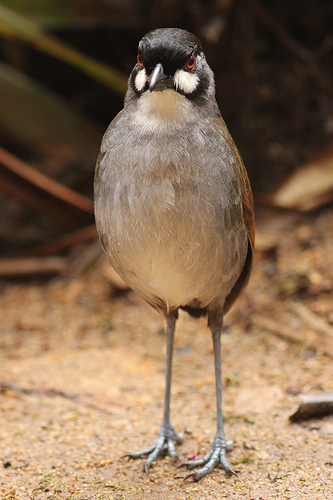
The huge and spectacular Jocotoco Antpitta has become a symbol of conservation in Ecuador and is resident at the Tapichalaca Reserve. Photo: Rich Hoyer
Although Ecuador is renowned for epic birding, the south stands out like a string of pearls—accessible and vastly different habitats supporting an astounding diversity of species and most of this small country’s endemics. We’ll sample these habitats, from the paramo above treeline in the high Andes, to the rainforest of the Amazonian foothills, to the elfin forest and lush cloud forest of the southeast, to the dry thorn scrub and deciduous forest of the southwest, and to the edge of mangrove woodland along the coast. Each has its own specialty birds, and each is close by comfortable and often brilliantly situated accommodation. This tour is perfectly set up for a memorable two-and-a-half weeks of birding.
Day 1: Everyone should arrive in Guayaquil by this evening for our introductory dinner. Night in Guayaquil.
Day 2: We’ll start the tour birding south of Guayaquil in the diverse coastal forest reserve at Manglares-Churute. This remnant mangrove forest bordered by dry forest and agricultural fields (rice paddies) is awash with interesting bird life and we have chances here for the southwestern forest specialties like Jet Antbird, Baird’s Flycatcher, and Orange-crowned Euphonia. Further, the rice fields and wetlands often have waders and shorebirds and Horned Screamers and unbelievable numbers of Snail Kites, and the mangrove forests have Mangrove Yellow Warbler. We’ll continue south from there into the low foothill rainforest of Jocotoco’s Buenaventura Reserve and the very comfortable Umbrellabird Lodge.
Day 3: The Buenaventura Reserve protects some of the most threatened forest in the country, and the drive there through mostly cleared pasture makes one appreciate the value of this spectacular piece of forest. We’ll have breakfast to the sounds of distant Howler Monkeys and squabbling hummingbirds before we take a hike to look for the namesake of the lodge: the amazing Long-wattled Umbrellabird which has a lek nearby. Its foghorn call is often heard, and we should be able to find one or more sitting unobtrusively in the forest sub-canopy.
The reserve also protects the scarce and local El Oro Parakeet, which we have a chance of seeing at the upper end of the reserve. We may get to see a few Club-winged Manakins displaying or a White-tipped Sicklebill tap into a heliconia flower. We could run into Gray-backed Hawk, Barred Puffbird, or Ochraceous Attila among throngs of other birds. The fruit feeders around Umbrellabird Lodge’s dining area can attract tanagers, araçaris, and coatis, and its hummingbird feeders are among the best in Ecuador. Night at Umbrellabird Lodge.
Day 4-5: After another morning of birding the rainforest, we’ll depart Buenaventura for a very different habitat, spending the next two days birding dry country—tropical deciduous forests and arid thornscrub—for the specialty birds of this seemingly strange habitat in a country mostly known for being lush and green. We’ll bird the Jorupe Reserve, another Jocotoco Foundation property, and spend two nights at the Jorupe Reserve’s Urraca Lodge. Notable birds to look for include Henna-hooded Foliage-Gleaner, Watkins’s Antpitta, Blackish-headed Spinetail, and Ecuadorian Piculet – but, even the fairly common species like Whooping Motmot, Scarlet-backed Woodpecker, Speckle-breasted Wren, and Chapman’s Antshrike are worthy distractions. The feeders at the lodge are usually busy in the morning with Rufous-headed Chachalacas, Blue Ground-Doves, White-tailed Jays, and Plumbeous-backed Thrushes. Nights at Urraca Lodge.
Day 6: Leaving Jorupe, we’ll travel across more arid country, but spending the morning in the high-elevation stunted forest of the tiny Utuana Reserve. Here we hope for Rufous-necked Foliage-Gleaner, Chapman’s Antshrike, and Glossy-black Thrush. The hummingbird feeders here usually have lots of Purple-throated Sunangels and Rainbow Starfrontlets. Descending from Utuana en route to the city of Loja, we’ll stop in the lower thornscrub for Tumbes Sparrow and the sneaky, but spectacular Elegant Crescentchest. Night in Loja.
Day 7: Today will be a varied day, beginning with the high-elevation part of Podocarpus National Park in the cloud forest of the Cajanuma sector just south of Loja, where we could find Equatorial Antpitta, Chusquea Tapaculo, Gray-breasted Mountain-Toucan, and perhaps a couple of flashy tanager flocks with the sublime Golden-crowned Tanager and ridiculous Grass-green Tanager catching the eye. After the morning there, things change fast, and we’ll first descend through arid, scrubby valleys, where Croaking Ground-Doves and Purple-collared Woodstars are possible, and finally we’ll go back up to reach the very humid high-elevation woodland of the Jocotoco Foundation’s wonderful Tapichalaca Reserve. Night at the homey Casa Simpson.
Day 8: At Casa Simpson we’re only steps away from excellent birding, starting with the hummingbird feeders on the front porch and perhaps Bearded Guans in the driveway. Surrounding the lodge, the Tapichalaca Reserve is the home of the flagship species of the Jocotoco nonprofit organization, and we’ll walk the forest trail to where the huge, spectacular Jocotoco Antpitta is now coming to earthworms at a feeding station. Golden-plumed Parakeets, White-throated Screech-Owl, Chestnut-naped Antpitta, Black-throated Tody-Tyrant, Dusky Piha, and White-capped Tanager are also possible while we wander the roads and trails that pass through the reserve. Also easily accessible from Casa Simpson are the upper reaches of the Río Marañon watershed, which flows south through the Amazonian foothills of Peru and marks a major ecological divide. Only a touch of this watershed enters the far southeast of Ecuador, and here we can find birds at the edge of their range, such as Black-faced Tanager, Marañon Thrush, and Rufous-fronted Thornbird. Night at Casa Simpson.
Day 9: After a final morning in the Tapichalaca Reserve and perhaps another stop back in upper Podocarpus National Park, we’ll end our day at Copalinga Lodge outside of the town of Zamora in the Amazonian foothills. Night at Copalinga Lodge.
Day 10: The charming Copalinga Lodge lies along the Río Bombuscaro at the eastern edge of the vast Podocarpus National Park. An easy trail along the river permits access to this lower elevation part of the park, and the list of potential birds is impressive. The brilliant Coppery-chested Jacamar and the local White-necked Parakeet are possible, as are more subtle species such as Black-streaked Puffbird and the recently described Foothill Elaenia. The grounds of Copalinga Lodge are superb for birding as well: fruit feeders can attract tanagers, euphonias, Speckled Chachalacas, and Red-crested Finch, Andean Cock-of-the-rock sometimes feasts in the palms and cecropias, and Little Woodstar occasionally visits the verbena. There is also a bird-feeding station back off in the woods that attracts a Gray Tinamou. Night at Copalinga Lodge.
Day 11: After a morning of birding around the lodge or back at the park, we’ll drive farther east. As the elevation sinks toward lower Amazonian foothill habitat, we could encounter Green-backed Trogon, Long-tailed Tyrant, raucous Black-capped Donacobius, and a few new tanagers like Turquoise, Masked, and Yellow-bellied. We’ll reach our lodge, Cabañas Yankuam, in time to settle in and perhaps do a little birding before dinner (in the late afternoon there are often White-tipped Swifts flying against the cliffs). Night at Cabañas Yankuam.
Day 12: Cabañas Yankuam lies along the Río Nangaritza in the Cordillera del Condor, a special habitat on a sedimentary stone tepui spur ridge of the Andes and home to near-endemic species and others at range limits or in isolated populations. Orange-throated Tanager is striking and will be a species for which we will have particular focus, but other likely prizes include Purplish Jacamar, Zimmer’s Antbird, and Gray-tailed Piha. In these primeval forests literally at the end of the road, Black-and-white Tody-Flycatcher and Fiery-throated Fruiteater are resident, and Ecuadorian Tyrannulets are almost common. Other birds occasionally seen along the road here are Lemon-throated Barbet, Yellow-backed Tanager, Slaty-capped Shrike-Vireo, and White-bellied Pygmy-Tyrant, yet another bird known in Ecuador only from this location. One feels on the verge of a great discovery every step of the way in the forests of this remote locale. Night at Cabañas Yankuam.
Day 13: We’ll bird the area around Cabañas Yankuam this morning before returning west and back up into the mountains. Night in Loja.
Days 14: From Loja we’ll go north to bird some high elevation forests near the town of Saraguro. We’ll keep an eye and ear out for tanager flocks, and we might bump into some mountain specialties like Glowing Puffleg, Mouse-colored Thistletail, or Loja Tapaculo. Leaving here, we’ll get even more mountainous and drive west deep into the Andean ridges to the remote mountaintop of Cerro de Arcos. If there is good weather in the afternoon we will make our first attempt at finding Blue-throated Hillstar, a hummingbird only first discovered in 2017 and known only from this location. Night at Casa Refugio Cerro de Arcos.
Day 15: We will spend the morning birding the area around the lodge, where, in addition to the Blue-throated Hillstar, other above tree-line specialties can be found. Jameson’s Snipe is often calling in the pre-dawn around the lodge and we may be able to track one down. Streak-backed Canastero, Black-billed Shrike-Tyrant, and both Mountain and Carunculated Caracaras are all possible. The hummingbird feeders around the lodge can have Shining Sunbeam, Great Sapphirewing, and Virdian Metaltail. We will stay until lunch then drop north through some desolate rain-shadow terrain toward the acacia woodlands of the scenic Yunguilla Valley. Night in La Union.
Day 16: We’ll start in the acacia woodlands of the Yunguilla Reserve that protects the tiny range of the critically endangered Pale-headed Brushfinch, a species rediscovered after being unrecorded for decades. They’re fairly common in the shrubby parts of the reserve and usually come in to the bird feeder, as often does Gray-browed Brushfinch and sometimes even a Chestnut-crowned Antpitta. From here we’ll drive up and north to the edge of El Cajas National Park on the outskirts of Cuenca, Ecuador’s third-largest city. Time permitting, we may stop on the way up at one of the “miradors” for a look out over the scenic countryside or pop into some polylepis woodland for a shot at a Giant Conebill. Night near Cuenca.
Day 17: Today we’ll be out birding near and above tree-line in El Cajas National Park, where we can expect such characteristic high-elevation species as Tawny Antpitta, Blue-mantled Thornbill, Chestnut-winged and Stout-billed Cinclodes, and Tit-like Dacnis, and we can at least hope for the endemic hummingbirds, Ecuadorian Hillstar and Violet-throated Metaltail, all against the dazzling backdrop of the high Andes. Depending on the weather and time, we may make a few last stops in our afternoon drive to Guayaquil for our final night in Ecuador. Night in Guayaquil.
Updated: 17 November 2023
Prices
- 2024 Tour Price : $6,890
- Single Occupancy Supplement : $780
Notes

Questions? Tour Manager: Greg Greene. Call 1-866-547-9868 (US or Canada) or (01) 520-320-9868 or click here to email.
This tour is limited to seven participants and one WINGS leader.
